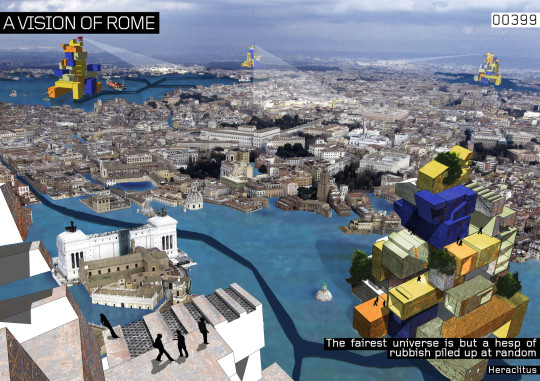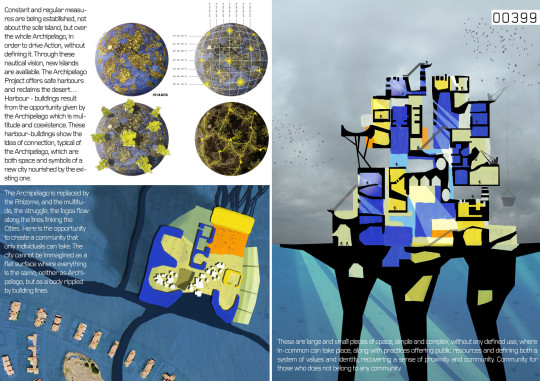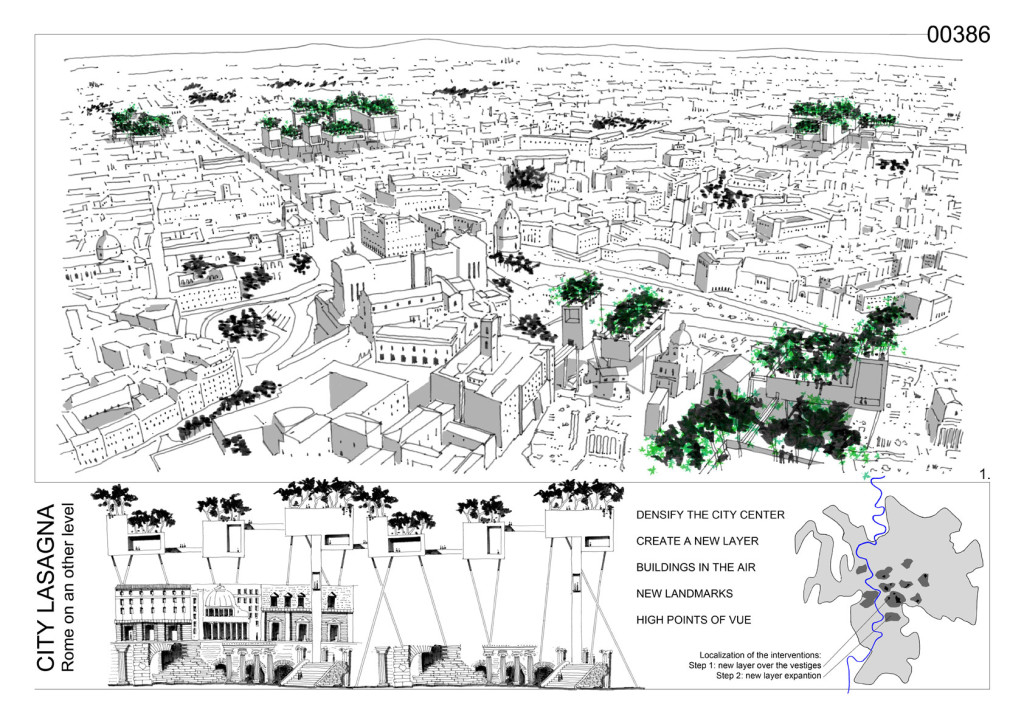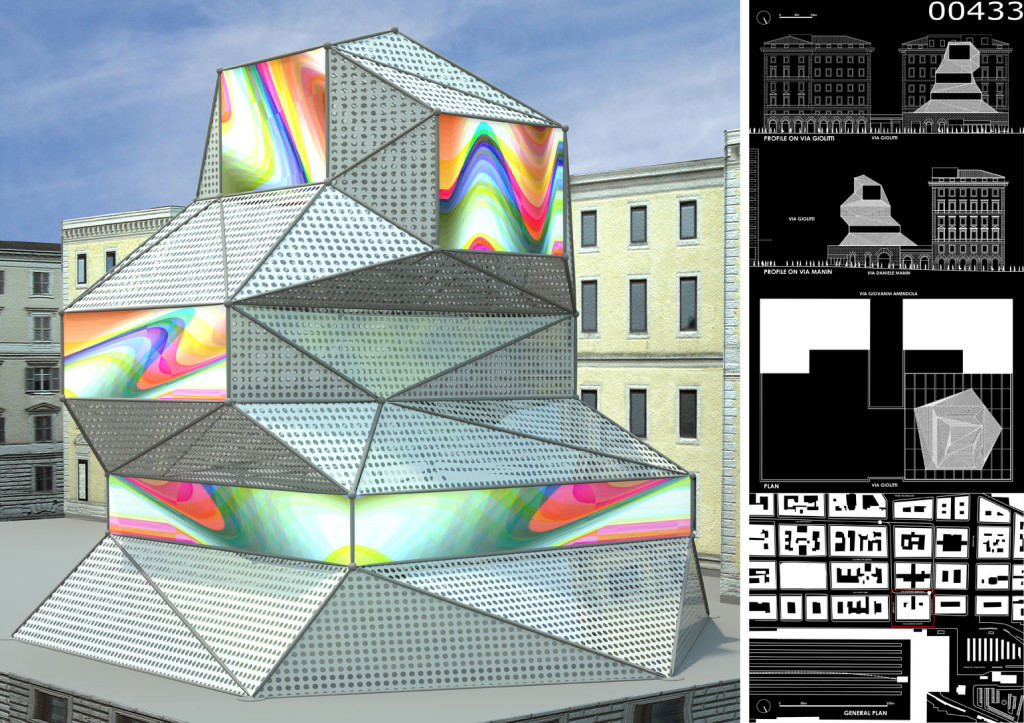Info:
Title: A vision of Rome - Code: 00399Contest: Rome / 2010
By: G. Caudo / M.G. Galasso / A. Giacomini / L. Greco / F. Griner / M. Leonori / S. Mannocci / S. Sebastianelli
Views: 2312 Likes: 0
Votes:
JUERGEN MAYER H. 0 FRANCESCO LIPARI2 FELIPE ESCUDERO7 FRANCESCO GATTI 9 MICHAEL CATON 44.4
A vision of Rome


0. The fragmentary city is crossed by island-sketching crevices: these fragments are inhabited by isolated individuals who are overwhelmed by a self-confident ego and unable to meet each other. Water fills up the crevices, flows into the cracks and submerges the in-common space, condemning it. This space is submerged, together with the ability to take action – which can only be in common – replaced by a hectic ego. In this city, common interests and values are opposed to one another: resulting in ghettos and enclaves. This is what has left about relationships with the Other, in this oversized and “creviced” city. Sometimes, we get by.
1. Islandsrise up from the water filling up the crevices: future settings are now available. This archipelago is never coherent and always suspended between forms of healthiness, pretending to be different. This forces us to wonder about the in-common space and ask for a global description. A unifying and linking approach is absolutely necessary. How can we put together different points of view, interests and forms of reason? The unavoidable clash becomes resourceful and encourages to build up new islands where an individual can be defined against the Other. In this clash, struggling individuals appear more clearly: in this clash, the Other’s reality rises up, different and incomprehensible. From this matching point, we are forced to think about ourselves and our limits, in order to stand the comparison. Looking for our identity, we can find our diversity.
2. Constant and regular measures are being established, not about the sole island, but over the whole Archipelago, in order to drive Action, without defining it. Through these nautical vision, new islands are available. The Archipelago Project offers safe harbours and reclaims the desert… Harbour-buildings result from the opportunity given by the Archipelago which is multitude and coexistence. These harbour-buildings show the idea of connection, typical of the Archipelago, which are both space and symbols of a new citynourished by the existing one. Difference tends to relationship and goes towards a common logos. The in-common space is mostly words, is dialogue, as long as the city is polèmos, clash. The words going towards the Other, premise and promise to common action, shapes island-buildings where the multitude takes place. Pictures gave over the identity in the city, its power, regulation and knowledge systems, to affirm that the in-common throughout the word can exist. Water, which previously stifled, is now supporting power allowing the building of anew city. Sometimes we do not get by.
“The fairest universe is but a hesp
of rubbish piled up at random”
Heraclitus, fragment 124
3. These buildings emerge from the water like new islands in the Archipelago: these are the Cities. The in-common place is shaping what already exists and is re-inventing the everyday life. These are large and small pieces of space, simple and complex, without any defined use, where in-common can take place, along with practices offering public resources and defining both a system of values and identity, recovering a sense of proximity and community. community for those who does not belong to any community. “With” in every form of co-existence and dialogue is still the place for difference and clashing of values. The submerged urban area rises along the buildings. The city re-appears. Poor energy and natural resources, the question of waste disposal and recycling, ideological conflicts represent occasions for common learning and awareness processes. Innovation becomes a collective process, not ephemeral and consumerist. The network is system, exchange and participation with other islands (the other cities) of the Archipelago. Not ivory towers, where in-common is confined, but lighthouses and harbours: in these buildings, proximity to the Other, or more exactly with the Other, can be found in the ability to create a common world which does not destroy single worlds. This common world is always changing.
4. From these islands, from these Cities, action offers new ways of shaping tensions for the in-common recovering the city. From the Archipelago, which is now dried up, an organic multitude, and not the single island, rises up. The Archipelago is replaced by the Rhizome, and the multitude, the struggle, the logos flow along the lines linking the Cities. Here is the opportunity to create a community that only individuals can take. The city cannot be immagined as a flat surface where everything is the same, neither as Archipelago, but as a body rippled by building lines. The Rhizome has no points nor positions, as in a building, a tree or a root. There are only lines. A rhizome does not start and does not end up, it is always between things. Not crossing trajectories, not opening paths, but breaches wilfully built up to allow Other’s access. Going towards proximity does not imply a passage from the dark of the night to the light of the day, but finding out a way to the light in the darkness.
A third city is born: night has fallen, the process is finished, the city is built, the multitude is inhabited: political ecology has now its institutions” Sometimes we cannot and should not get by.






